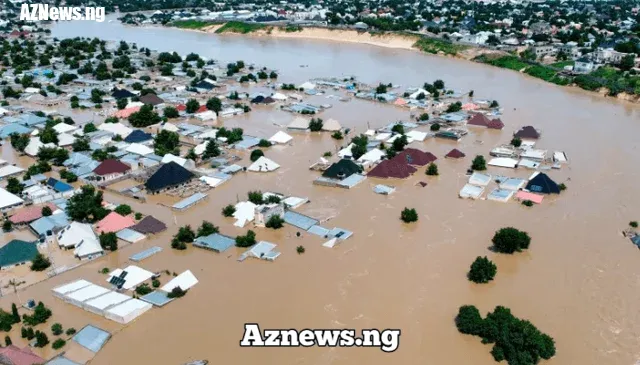
The devastating flooding that has submerged about 70 percent of Maiduguri, capital of Borno State, may further pile pressure on Nigeria’s already strained food crisis and worsening hunger......Read The Full Article>>.....Read The Full Article>>
Heavy flooding has so far affected one million farmers and residents of Nigeria’s northeast, where sorghum, tomatoes, rice, millet and sesame are produced, the authorities said. The region is big in livestock and cattle production.
The insurgency-hit Borno State grows maize, yam, cassava, sorghum, cowpea, sorghum, millet, sweet potato and rice, pushing them down South.
Severe flooding has also affected Ebonyi, Sokoto, Benue, Kano, Niger, Plateau, Kwara, all food-belt states.
About 1,664 persons were sacked in Sokoto in July as floods ravaged four communities in the state. In Benue State, Nigeria’s food basket, 1,000 houses and farms were affected by heavy flooding in July. More than 100 households were also devastated by flood in Benue in August.
In Jigawa State, heavy flooding hit 14 local government areas in mid-August, affecting 40,000 people and over 80,000 households. Twenty-eight persons lost their lives in the process.
In September, floods hit Okpuitumo Community in Abakaliki Local Government Area of Ebonyi State, destroying many farmlands.
Also, the Kano State Emergency Management Agency said that heavy flooding had killed 49 persons, affecting 226 communities across 27 local government areas of the state from January 2024 to September 12, 2014.
Niger State is still struggling to rehabilitate 13,965 farmers affected by previous flooding, but over 89 houses were hit by a new flood disaster in August.
While Ebonyi farms rice, cassava and tomatoes, Niger State produces pine apple, bananas, mango, water melon, sugar cane and soy beans.
Kano grows rice, maize, wheat and tomato, while Jigawa produces millet, sorghum, cowpea, groundnuts, sesame, rice, and maize.
Benue is Nigeria’s food basket, growing everything from yams to rice and oranges.
Kwara grows yams, corn (maize), sorghum, millet, onions, and beans.
“You know that this is just the beginning of the heavy flooding that will affect 31 states in Nigeria. Most of these states produce food. The flooding will affect farms and destroy crops, thereby reducing food supply,” said Aniemeka Okeowo, a flood risk consultant.
“We have to act now until it is late,” she warned.
According to a report by SB Morgen, a Lagos-based data-driven intelligence firm, Nigeria and many African countries are grappling with severe flooding crises.
“The long-term risk includes a significant challenge to Nigeria’s food security, which is already strained by violence, insecurity, and crises related to storage and foreign exchange,” SBM Intel said.
Nigeria is combating elevated food and energy prices. The nation’s inflation dropped to a six-month low of 32.15 percent in August from 34.40 percent in July, but the realities at the market are still a far cry.
Food inflation, which accounts for over 50 percent of Nigeria’s headline inflation, also decelerated to 37.52 percent on seasonal harvest. But prices of rice, beans, bread and other processed staples are still relatively high.
“With the recent insecurity that has the worst hit Borno state, food production (crop/animal and fishing) contribute to only 5.9 percent of the food needs of the state,” Food and Agriculture Organization (FAO) said in a report
“Virtually, 94 percent of food consumed in Borno is imported either in the form of credit or gift from non-governmental organizations (NGOs), world food program (WFP), and civil societies among others,” it added.
According to a Nigeria Impact of Flood, Recovery and Mitigation Assessment Report published in 2023, 49 percent of households reported having had their main source of food affected by the floods, with households in rural areas (60 percent) more impacted than those in urban areas (23 percent).
Across the states, Bayelsa and Jigawa residents recorded the highest percent of food sources being affected at 87.2 percent, while Anambra had 18.4 percent, the lowest among Nigerian states.
About 3.2 million Nigerians were affected by the 2022 flooding.
In 2022, Nigeria experienced the worst flooding in recent decades, with over 600 fatalities and 3.2 million people affected across 34 of the 36 states of the federation and the Federal Capital Territory.
While flooding occurs annually in Nigeria, the 2022 flooding caused unprecedented disruption and destruction and proved to be more intense than the 2012 floods, where approximately three million families saw their houses damaged or destroyed.
Borno’s flood worst in 30 years
Borno State has experienced its most devastating flood in 30 years, largely due to the Alau Dam’s inability to manage overflow.
This has led to the displacement of almost half a million residents and the death of 37 people.
The now one-week-old disaster resulted in jailbreak and the death of about 80 percent of the animals at the Sanda Kyarimi Park Zoo.
“Despite the warnings, there is little evidence of proactive measures to prevent or mitigate the damage. It has become a pattern: floods arrive, displace thousands, destroy homes and farmlands, and leave survivors at risk of disease and hunger. Then, the cycle repeats the following year,” SBM Intel said.
SBM Intel said breaking the cycle means there must be a fundamental shift in policy and culture, noting that flood risk management must become a national priority, focusing on prevention rather than reaction.
“This includes developing reliable early warning systems, implementing robust urban planning regulations, and ensuring flood-prone areas are adequately equipped to handle excess water,” the research firm said.
